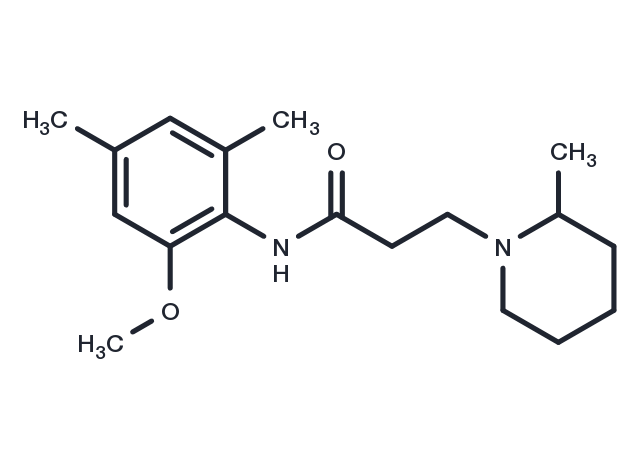Powder: -20°C for 3 years | In solvent: -80°C for 1 year


Vadocaine (Vadocaina) is a novel analgesic compound for local anaesthesia and can be used to study the central nervous system and cardiovascular system.

| Pack Size | Availability | Price/USD | Quantity |
|---|---|---|---|
| 1 mg | In stock | $ 143.00 | |
| 5 mg | In stock | $ 360.00 | |
| 10 mg | In stock | $ 530.00 | |
| 25 mg | In stock | $ 859.00 | |
| 50 mg | In stock | $ 1,180.00 | |
| 100 mg | In stock | $ 1,590.00 |

| Description | Vadocaine (Vadocaina) is a novel analgesic compound for local anaesthesia and can be used to study the central nervous system and cardiovascular system. |
| In vivo | In guinea pigs, vadocaine reduced by about 70% the cough episodes induced by sulphur dioxide or ammonia. The effective dose was 2.5 mg/kg p.o., and codeine phosphate was less effective. In cats, vadocaine (3 mg/kg i.v.) inhibited by about 80% for 10 min the cough reflex initiated by mechanical irritation of the trachea. When vadocaine was given via the vertebral artery, it was about 10 times more active than by the intravenous route. Codeine was 3 times as active as vadocaine by both routes. This result indicates an important central component in the antitussive action of vadocaine. In another cat model, 5 mg/kg of vadocaine was somewhat weaker than 1 mg/kg of codeine in inhibiting the cough caused by electrical stimulation of the laryngeal nerve (Domenjoz's method). In dogs, both oral and intravenous doses of 6 mg/kg of vadocaine and 2 mg/kg of codeine were approximately equiactive, inhibiting by 60-80% the cough induced by electrical stimulation of the trachea. Concentrations of vadocaine in serum were around 1 microgram/ml during oral administration. By both routes, the antitussive activity (inhibition of cough by 50% or more) lasted at least 2 h. Vadocaine caused local anaesthesia in the guinea pig wheal preparation at concentrations of 0.25% and 0.5%, and on the guinea pig cornea at 0.5%. The duration of anaesthesia was longer than that of lidocaine. Vadocaine did not affect the guinea pig tracheal strip preparation.[1] |
| Synonyms | Vadocaina, Vadocainum |
| Molecular Weight | 304.43 |
| Formula | C18H28N2O2 |
| CAS No. | 72005-58-4 |
Powder: -20°C for 3 years | In solvent: -80°C for 1 year
You can also refer to dose conversion for different animals. More
bottom
Please see Inhibitor Handling Instructions for more frequently ask questions. Topics include: how to prepare stock solutions, how to store products, and cautions on cell-based assays & animal experiments, etc.
Vadocaine 72005-58-4 Others Vadocaina Vadocainum inhibitor inhibit
